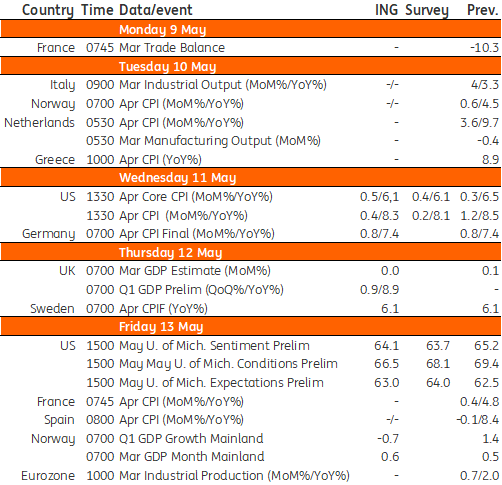
Image Source: Unsplash
The US Fed will continue with 50bp rate hikes throughout this year despite the fall in CPI figures expected next week. However, the lack of activity in the UK may put a dent in the Bank of England's plans.
US: Inflation may be past its peak
Consumer price inflation is the key number out of the US next week and it should hopefully show inflation has passed the peak with the year-on-year rate slowing from 8.5% to 8.3%, and core inflation edging down to 6.1% from 6.5%. Lower gasoline prices will be a big help, as will a drop in second-hand car prices as heralded by data from the Mannheim car auctions. However, it will be a long slow descent to get to the 2% target. China’s zero-Covid strategy will continue to pressure supply chains as production and distribution of inputs remain disrupted. Geopolitical tensions add to the problems, while the incredibly tight labor market is also putting upward pressure on wages and labor costs more broadly. In an environment of strong corporate pricing power, these costs are being passed onto customers, meaning inflation will be sticky and slow to fall. As such, the Fed will continue to hike rates swiftly with 50bp rate hikes expected in June, July, and September.
Consumer confidence will also be published by the University of Michigan and equity market weakness coupled with anxiety over the rising cost of living looks set to keep sentiment subdued.
UK first-quarter bounce to mask weaker performance in March
A strong bounce in UK activity during January should be enough to put in a quarterly growth figure just shy of 1%. But this masks less exciting performance as the quarter went on, and we expect the monthly GDP figure for March to show no growth in economic activity overall. Retail sales fell for the second consecutive month, while health output probably fell again ahead of the end of free Covid testing at the end of that month. That latter factor, combined with early signs of the cost of living squeeze, as well as an extra bank holiday, suggests we should brace for a negative second-quarter GDP figure and indeed weak activity for the rest of 2022. Increasing concerns surrounding growth likely means the Bank of England will hike fewer times than markets expect this year. We expect further increases in June and August before the committee presses the pause button.
Developed Markets Economic Calendar

Image Source: Refinitiv, ING, *GMT
Disclaimer: This publication has been prepared by the Economic and Financial Analysis Division of ING Bank N.V. (“ING”) solely for information purposes without regard to any ...
more
Disclaimer: This publication has been prepared by the Economic and Financial Analysis Division of ING Bank N.V. (“ING”) solely for information purposes without regard to any particular user's investment objectives, financial situation, or means. ING forms part of ING Group (being for this purpose ING Group NV and its subsidiary and affiliated companies). The information in the publication is not an investment recommendation and it is not investment, legal or tax advice or an offer or solicitation to purchase or sell any financial instrument. Reasonable care has been taken to ensure that this publication is not untrue or misleading when published, but ING does not represent that it is accurate or complete. ING does not accept any liability for any direct, indirect or consequential loss arising from any use of this publication. Unless otherwise stated, any views, forecasts, or estimates are solely those of the author(s), as of the date of the publication and are subject to change without notice.
The distribution of this publication may be restricted by law or regulation in different jurisdictions and persons into whose possession this publication comes should inform themselves about, and observe, such restrictions.
Copyright and database rights protection exists in this report and it may not be reproduced, distributed or published by any person for any purpose without the prior express consent of ING. All rights are reserved. ING Bank N.V. is authorised by the Dutch Central Bank and supervised by the European Central Bank (ECB), the Dutch Central Bank (DNB) and the Dutch Authority for the Financial Markets (AFM). ING Bank N.V. is incorporated in the Netherlands (Trade Register no. 33031431 Amsterdam). In the United Kingdom this information is approved and/or communicated by ING Bank N.V., London Branch. ING Bank N.V., London Branch is deemed authorised by the Prudential Regulation Authority and is subject to regulation by the Financial Conduct Authority and limited regulation by the Prudential Regulation Authority. The nature and extent of consumer protections may differ from those for firms based in the UK. Details of the Temporary Permissions Regime, which allows EEA-based firms to operate in the UK for a limited period while seeking full authorisation, are available on the Financial Conduct Authority’s website.. ING Bank N.V., London branch is registered in England (Registration number BR000341) at 8-10 Moorgate, London EC2 6DA. For US Investors: Any person wishing to discuss this report or effect transactions in any security discussed herein should contact ING Financial Markets LLC, which is a member of the NYSE, FINRA and SIPC and part of ING, and which has accepted responsibility for the distribution of this report in the United States under applicable requirements.
less
How did you like this article? Let us know so we can better customize your reading experience.













